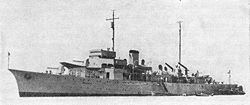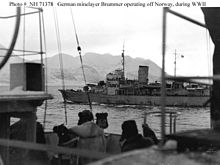Brummer (ship, 1932)
|
As Olav Tryggvason
|
||||||||||||||||||
|
||||||||||||||||||
|
||||||||||||||||||
|
||||||||||||||||||
|
||||||||||||||||||
The Brummer was a Norwegian mine-layer that was confiscated and reused by the German Navy after the occupation of Norway .
Norwegian mine-layer Olav Tryggvason
The ship was launched on December 21, 1932 with the Navy Hovedverft ( Karljohansvern ) in Horten , Norway and put into service in the Norwegian Navy on June 21, 1934 . It was named after the medieval Norwegian king Olav Tryggvason . The ship was 97.3 m long and 11.5 m wide, had a draft of 4.0 m and displaced 1,860 tons. The maximum speed was 22 knots, the range 3,000 nautical miles at 14 knots.
The armament consisted of four 12 cm L / 44 guns from Bofors , a 7.6 cm flak, two 4.7 cm MK and two 12.7 mm Colt machine guns. The ship could carry up to 280 mines and lay them on the move. In peacetime it was intended to be used as a training ship, for which a twin tube group for 45.7 cm torpedoes was installed.
Navy
During the German invasion of Norway ( Operation Weser Exercise ) in World War II, the ship, together with the minesweeper Rauma , sank the German minesweeper R 17 in Horten am Oslofjord in the early morning of April 9, 1940 , but then fell the following day during the surrender of Hoarding in German hands. Two days later it was taken over into the Navy under the name Albatros , but then renamed Brummer on May 16, 1940 , in honor of the artillery training ship Brummer, which sank on April 9, 1940 .
The ship was now equipped with four 12.7 cm guns, two 3.7 cm guns and four 2 cm anti-aircraft guns, from the summer of 1943 with three 10.5 cm anti-aircraft guns, two 3.7 -cm-Flak and ten 2-cm-Flak. It was initially used to lay mine barriers off the Belgian and Dutch coasts, and from 1941 in the Baltic Sea.
Together with the former maritime port ships Roland and Cobra on 7./8. The offensive mine barrier "SW 1", which was laid in the southwestern North Sea on August 31, 1940 was the undoing of the British 20th (mine-laying) destroyer flotilla on August 31, when the Express , Esk and Ivanhoe ran into mines in the previously undetected barrier. The Esk sank immediately, the Ivanhoe was badly damaged and sunk by its own fuse as not towable, and the Express lost its forecastle, but could be towed in and was out of action for over twelve months.
During the entire war it also took over escort duties again and again. From 1942 to 1944 it was in service in the North Sea and off Norway. In 1944 it returned to mine-laying operations in the Baltic Sea, where it was used in the spring of 1945 to evacuate German refugees from the eastern provinces ( Hannibal Company ).
The End
During an air raid on Kiel on April 3, 1945, the Brummer , lying in the construction port of Deutsche Werke , was badly damaged. The wreck was scrapped after the war between 1945 and 1948.
literature
- Helmuth Haupt, Siegried Breyer: Mining ship Brummer (II) 1940-1945. The fate of the Norwegian miner Olav Tryggvason. (Marine-Arsenal Volume 43), Podzun-Pallas Verlag, Wölfersheim-Berstadt 1999, ISBN 3-7909-0661-1
- Erich Gröner : The ships of the German Navy and Air Force 1939–45 and their whereabouts. JF Lehmann Verlag, Munich 1954.
- Erich Gröner, Dieter Jung, Martin Maass: The German warships 1815-1945. Volume 3: Submarines, auxiliary cruisers, mine ships, net layers and barrier breakers. Bernard & Graefe Verlag, Koblenz 1985, ISBN 3-7637-4802-4 .
- Robert Gardiner, Roger Chesneau: Conway's All the world's fighting ships 1922-1946. Conway Maritime Press, London 1980, ISBN 0-8317-0303-2 .
- Hans H. Hildebrand, Albert Röhr, Hans-Otto Steinmetz: The German warships . Volume 9: Historical Overview . Collective chapter landing craft, mine ships, minesweepers, speedboats, training ships, special ships, tenders and escort ships, torpedo boats, supply ships. Mundus Verlag, 1999, OCLC 247353137 .
- Karl von Kutzleben, Wilhelm Schroeder, Jochen Brennecke: Mine ships 1939–1945. The mysterious missions of the “midnight squadron”. Köhler, Hamburg 2002, ISBN 3-7822-0844-7 .
Individual evidence
- ↑ Gröner 1985, p. 184.
- ↑ site navweaps. Weyer's pocket book of the war fleets 1941/42. Haupt, Breyer, p. 4.
- ↑ Gröner 1954
- ↑ Haupt, Breyer, p. 4.
- ↑ The crew of the torpedo boat Albatros , which was lost on April 10, was transferred to the captured ship.
- ↑ Gröner 1954
- ↑ Gröner 1985, p. 184.
- ^ Rohwer : Sea War. 31.8./1.9.1940, North Sea
- ↑ Haupt, Breyer, pp. 18f.



